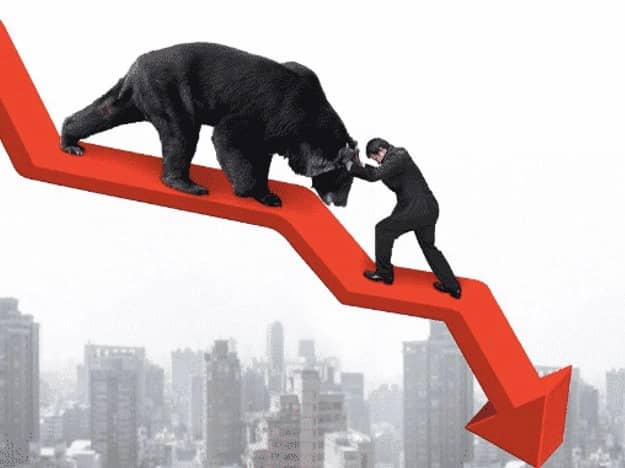Subscribe to wiki
Share wiki
Bookmark
Bear Market
The Agent Tokenization Platform (ATP):Build autonomous agents with the Agent Development Kit (ADK)
Bear Market
A bear market is a period of time when the prices of cryptocurrencies are falling or expected to fall. This usually happens when there is more supply than demand, and when investors are pessimistic about the future of the crypto industry. This term is commonly used to describe a scenario in which the prices of securities, including cryptocurrency assets declining by 20% or more from their recent peak levels. This decline is often accompanied by prevailing pessimism and a general sense of negative sentiment among investors.[1][2]
Overview
Investors who anticipate further price declines are commonly referred to as “bears.” Trading in bear markets can be challenging due to the difficulty in predicting when the market will bottom out and when prices will rebound. This rebounding process can be slow and unpredictable, influenced by various external factors such as economic growth, investor psychology, and global news or events.
However, bear markets can also offer opportunities. For those with a long-term investment strategy, purchasing during a bear market can yield profits when the cycle eventually shifts. Investors with shorter-term strategies can watch for temporary price surges or corrections. For more sophisticated investors, there are approaches like short selling, which profits from anticipated price declines. Another popular strategy among crypto investors is dollar-cost averaging, where an individual invests a fixed sum of money at regular intervals, regardless of whether the asset's price is rising or falling. This strategy spreads the risk and allows the investor to navigate through both bull and bear markets.[3]
The cryptocurrency market is characterized by its significant price fluctuations and the possibility of substantial profits, making it appealing to investors globally. Similar to the conventional stock market, cryptocurrencies also undergo periods of bullish and bearish market conditions.[6]
A defining feature of bear markets is the prevailing pessimism and diminished investor confidence. Positive news often goes unnoticed as investors continue to sell, driving prices further down. However, as stocks and digital assets become perceived as attractively priced, investors initiate buying activity, indicating the end of the bear market.[2][5][8]
Causes
Generally, events such as pandemics, political crises, slow economies, and wars may trigger the start of a bear market. However, there are three main causes of a crypto bear market: decreased investor confidence, high-interest rates, and economic recession. [5][7]
A bear market frequently coincides with a larger economic recession, characterized by sluggish growth or an outright contraction of the economy. In response to such conditions, central banks often opt to increase interest rates, rendering speculative choices such as cryptocurrencies comparatively less appealing or even impractical. This prompts investors to find more reliable investment alternatives such as bonds. [7][9]
Characteristics
A bear market in the crypto industry exhibits the following characteristics:
- Decreased trading volumes: This means that fewer people are buying and selling cryptocurrencies, which reduces liquidity and price discovery.[6][7]
- Increased Volatility: Bear markets are characterized by increased price volatility compared to bull markets. Prices can experience sudden and unpredictable fluctuations, making trading and investing in cryptocurrencies more challenging.[5][7]
- Sharp and Prolonged Price Decline: Typically, a crypto bear market witnesses a rapid initial price drop, followed by an extended period of continuous decline. This downward trend can persist for several months or even years.[5][7]
- Negative Sentiment: Negative sentiment prevails during bear markets as investors become pessimistic about the market's future prospects. This negativity can exacerbate the price decline, as individuals may be more inclined to sell.[6][7]
Examples
Some of the notable examples of crypto bear markets in history include the following:
2014/2015 Bear Market
The first large-scale crypto bear market followed an unexpected bull market in late 2013. First, an alleged market manipulation at Mt. Gox drove BTC prices from $200 to a record $1,236. [10] The erratic gain between early November and December 2013 was swiftly followed by a rapid collapse as most market players sought profits in a low-liquidity market. Two years of crypto winter followed, with the global market valuation falling from $15 billion to $3.5 billion at its lowest in early 2015. [10]
2018 Crypto Winter
This was a painful period when the price of Bitcoin dropped from its all-time high of nearly $20,000 in December 2017 to around $3,000 in December 2018, and many other cryptocurrencies also lost more than 80% of their value. The 2018-2019 bear market was caused by factors such as regulatory crackdowns, security breaches, scams, and technical issues in the crypto space.[10]
2021 Bear Market
This was a period when the price of Bitcoin fell from over $60,000 in April 2021 to below $30,000 in June 2021, and many other cryptocurrencies also suffered significant losses. The 2021 bear market was triggered by factors such as environmental concerns, the Chinese ban, tax enforcement, and market manipulation in the crypto industry.
2022 Bear Market
The year 2022 was referred to as an another ‘crypto winter’ due to a significant downturn in the cryptocurrency market. Cryptocurrencies lost $2 trillion in value since the height of a massive rally in 2021. This downturn was different from previous ones due to several factors:[13][14]
- The crypto market had been flooded with debt thanks to the emergence of centralized lending schemes.
- The collapse of the algorithmic stablecoin terraUSD.
- The current crash began earlier 2022 as a result of macroeconomic factors including rampant inflation that has caused the U.S. Federal Reserve and other central banks to hike interest rates.
- Bitcoin and the cryptocurrency market had been more broadly trading in a closely correlated fashion to other risk assets, particularly stocks.
Valuations in the cryptocurrency market in 2022 had dropped significantly from their all-time highs, with the total market capitalization losing around $2.2 trillion – a decline of around 73%. [12]
See something wrong?
The Agent Tokenization Platform (ATP):Build autonomous agents with the Agent Development Kit (ADK)
